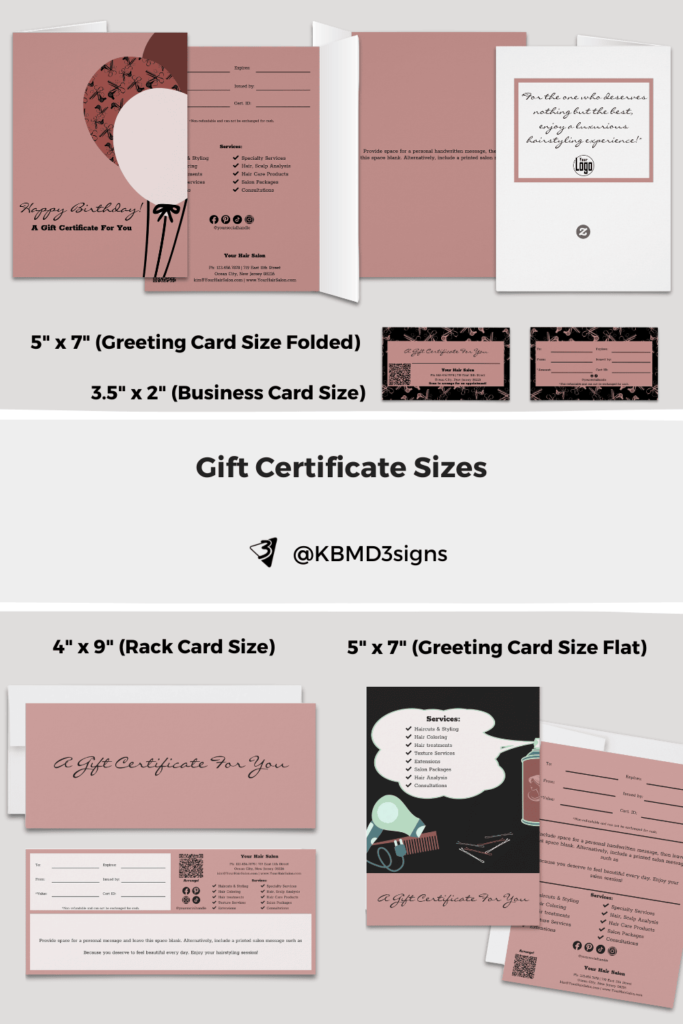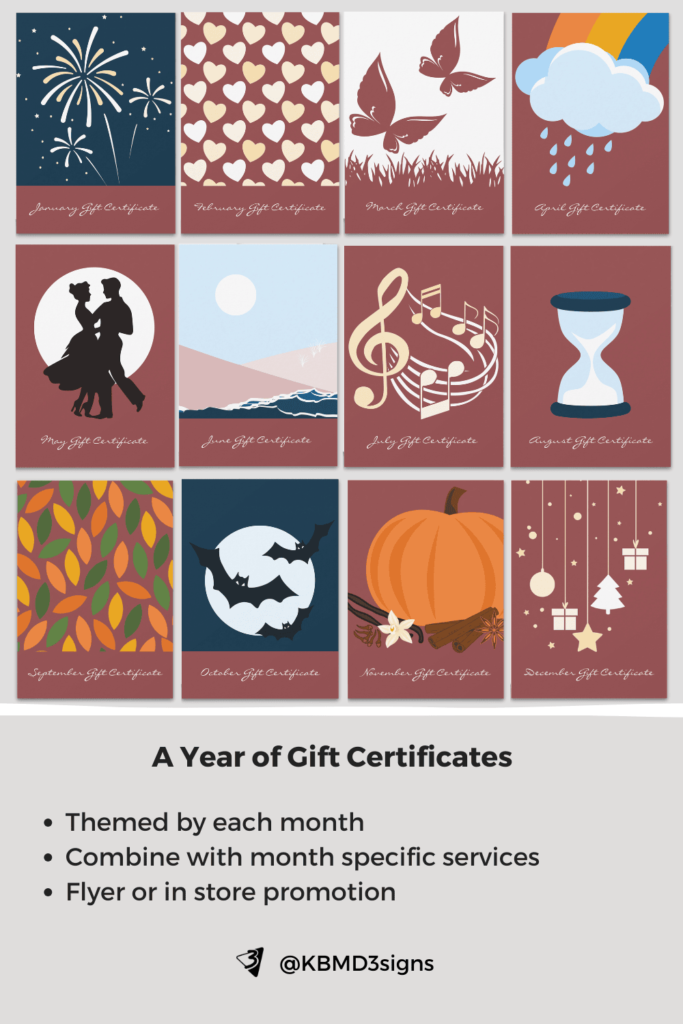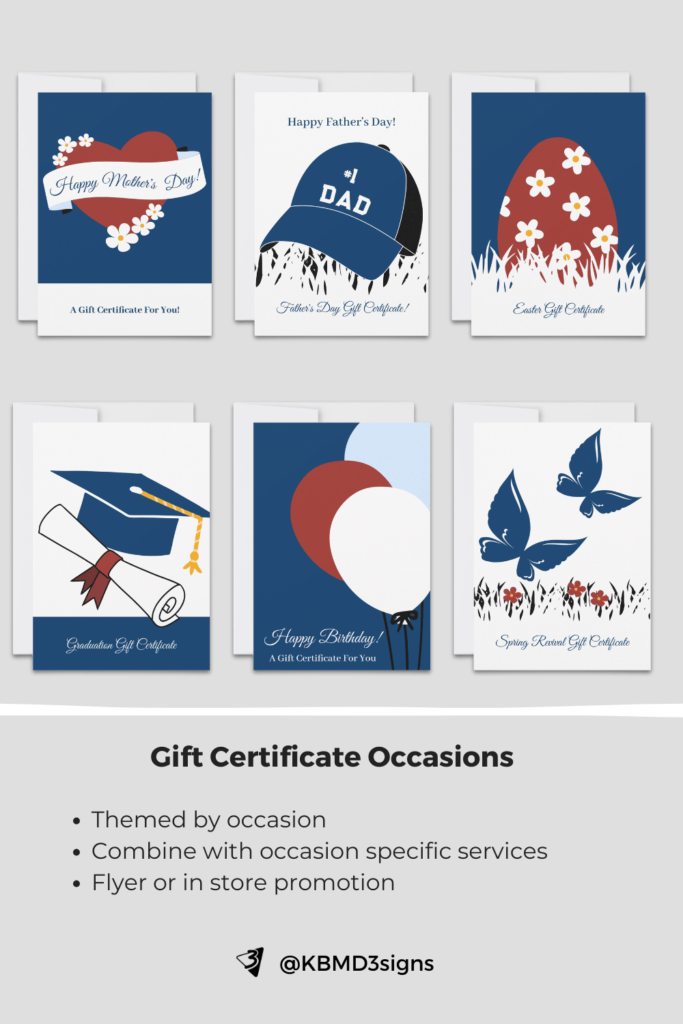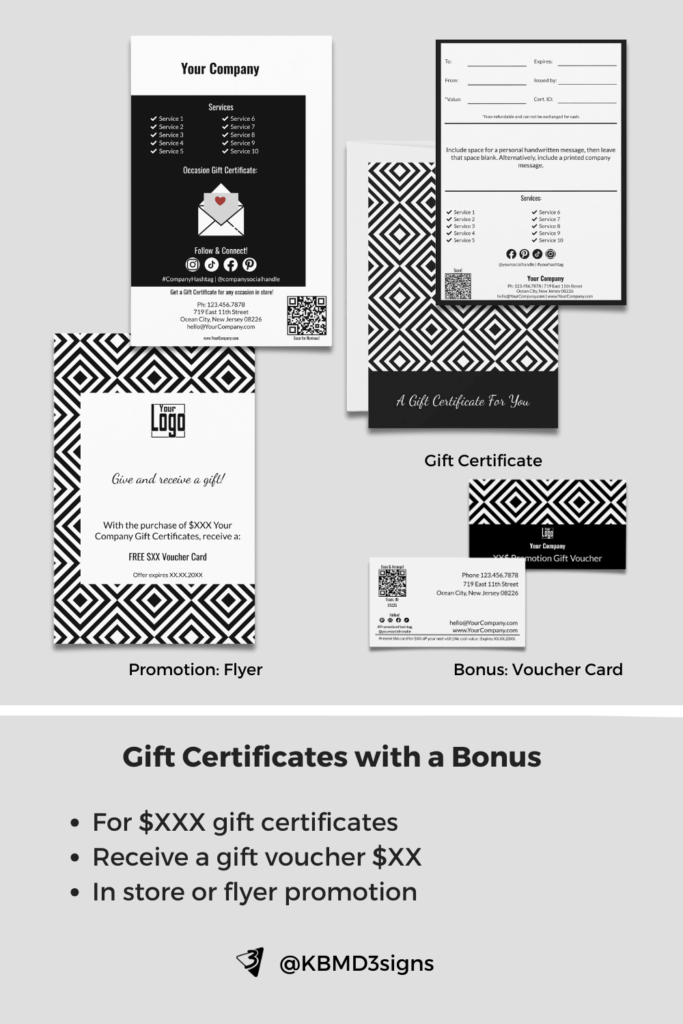Gift certificates are powerful tools for small service businesses, offering a versatile way to attract new customers, reward loyal clients, and increase revenue. From a small business perspective, a gift certificate is more than just a piece of paper or card; it represents potential future business, brand promotion, and customer satisfaction.
Article Content:
- Understanding Gift Certificates
- What is the difference between a gift card, gift voucher and a gift certificate?
- Gift Certificate Sizes and Formats
- Designing a Gift Certificate: Essential Elements for Small Service Businesses
- Sample KBM D3signs Gift Certificate Templates and Customization Options
- Seasonal Gift Certificate Promotions: A Step-by-Step Guide
- Ease of Implementation: Managing Sequential Tracking Codes for Printed Gift Certificates
- Frequently Asked Questions About “Gift Certificates”?
1. Understanding What Is a Gift Certificate?
A gift certificate is a prepaid voucher that allows the recipient to redeem it for services or products at the issuing business. Unlike gift cards, which are often plastic and linked to electronic systems, gift certificates are frequently printed on high-quality paper, making them suitable for small businesses without extensive digital infrastructure.
For small service businesses such as salons, spas, local shops, or fitness studios, gift certificates can serve as a thoughtful and personal gift option, particularly during holidays, birthdays, and special occasions. The personal touch of a printed gift certificate can make it feel more like a present than an electronic gift card, enhancing the customer experience.
The Value of Printed Gift Certificates
In a world increasingly dominated by digital interactions, printed gift certificates offer a tangible, offline marketing tool that stands out. Here’s why printed gift certificates are valuable:
- Personal Connection: Printed gift certificates can be customized with designs that reflect your brand’s personality. Handing over a beautifully designed certificate adds a personal touch that digital versions can’t replicate, making customers feel valued.
- Brand Visibility: Every time a gift certificate is given, your brand reaches a new audience. A well-designed certificate with your business’s name, logo, and contact information serves as a mini-billboard, subtly promoting your services to potential new clients.
- Flexibility in Distribution: Printed gift certificates can be sold at your location, given as part of a promotion, or distributed at community events. They can be included in thank-you notes, mailers, or welcome packages for new customers, seamlessly integrating into your offline marketing strategy.
- Enhanced Customer Loyalty: Offering gift certificates encourages repeat business. For example, a salon can offer certificates as rewards for referrals or as incentives during slow seasons. These certificates not only bring customers back but also enhance word-of-mouth marketing.
- Ease of Implementation: For small businesses without advanced point-of-sale systems, printed gift certificates are simple to manage. They don’t require expensive technology or software, just a reliable system for tracking sales and redemptions.
Offline Marketing with Gift Certificates
Printed gift certificates are an excellent addition to any offline marketing strategy. Here’s how small service businesses can leverage them effectively to build brand loyalty:
- Seasonal Promotions: Create themed gift certificates for holidays, Mother’s Day, or other special occasions such as Valentine’s Day. Highlight these in your shop window, local flyers, and direct mail campaigns.
- Cross-Promotions with Local Businesses: Partner with complementary businesses in your area to offer bundled services. For example, a hair salon and a nail spa could team up to create a “Pamper Package” gift certificate. This approach not only increases your reach but also builds community connections.
- Community Events and Sponsorships: Donate gift certificates as prizes for local charity events, raffles, or silent auctions. This not only helps a good cause but also raises awareness of your services among event participants.
- Customer Loyalty Programs: Use gift certificates as rewards for loyal customers. A “Buy 5, Get 1 Free” service certificate can encourage regular visits and long-term relationships.
- In-Store Displays: Position your gift certificates prominently near the checkout area. Customers making a purchase might be inspired to add a certificate as a gift for someone else, boosting your sales without additional marketing costs.
Conclusion
For small service businesses, gift certificates are more than just an additional revenue stream—they are a strategic offline marketing tool that fosters customer loyalty, enhances brand visibility, and connects with the local community. By embracing printed gift certificates, you can create lasting impressions and expand your customer base, all while providing a thoughtful and valuable service to your clients.
2. What is the difference between a gift card, gift voucher and a gift certificate?
From the perspective of a small service business, understanding the differences between a gift card, gift voucher, and gift certificate is important for offering the right options to customers:
- Gift Card:
Format: Often a physical or digital card with a preloaded balance.
Usage: Customers can use the card multiple times until the balance is exhausted.
Features: May include tracking, balance inquiries, and expiration dates.
Best For: Businesses offering a range of services or products where flexibility and repeat visits are common. - Gift Voucher:
Format: Typically a printed or digital slip with a specific monetary value.
Usage: Usually redeemed once for its face value, either in full or partial payment.
Features: May specify certain services or products and often have clear expiration dates.
Best For: Promoting specific services, discounts, or special offers. - Gift Certificate:
Format: Often a formal, printed document, sometimes with a custom design.
Usage: Redeemable for a specific service, product, or a fixed amount.
Features: More formal and personal, often suitable for gifting purposes like special occasions.
Best For: Services with a set price, like a haircut, spa session, or consultation.
Summary:
- Gift Cards offer flexibility and are ideal for repeat customers.
- Gift Vouchers are great for promotions and specific services.
- Gift Certificates provide a personalized, formal option for gifting specific services or amounts.
Small service businesses can use these tools to cater to different customer needs and gifting preferences.
3. Gift Certificate Sizes and Formats
Gift certificates come in various sizes and formats, each with its own benefits. The choice between a flat card or a folded card depends on your business’s branding, presentation preferences, and the type of customer experience you want to create.
Common Gift Certificate Sizes
- 3.5″ x 2″ (Business Card Size)
Format: Flat
Benefits: Compact and easy to carry in a wallet or purse, this size is convenient for both the giver and recipient. It’s also economical to produce and works well in a simple design. Ideal for businesses that want a sleek, minimalistic look. - 4″ x 9″ (Rack Card Size)
Format: Flat or folded
Benefits: Provides more space for additional details, such as terms and conditions, promotional messages, or branding elements. This size is often used for certificates that double as marketing materials. A folded version allows for more creative presentation, such as including a personal message or a design surprise inside. - 5″ x 7″ (Greeting Card Size)
Format: Flat or folded
Benefits: Larger size offers a more premium feel, making the certificate feel more like a gift in itself. A folded design can create an elegant presentation, with room inside for personal messages, signatures, or even a list of suggested services the certificate can be used for. This size is particularly effective for special occasions like weddings or holidays. - 8.5″ x 11″ (Letter Size)
Format: Flat or folded
Benefits: Offers the most space for comprehensive information, including full descriptions of services, terms, and branding. This size is often used for certificates that are meant to be framed or displayed. A folded version can create a formal presentation, often used in corporate settings or for high-value gift certificates.
Flat Cards vs. Folded Cards
Flat Cards
- Advantages:
Simplicity: Easy to produce and distribute.
Convenience: Fits easily into standard envelopes, wallets, or cardholders.
Cost-Effective: Typically less expensive to print and doesn’t require folding or additional finishing.
Branding Space: Provides a clean, straightforward canvas for your branding. - Considerations:
Limited Space: Offers less room for additional information or personalization.
Presentation: May not feel as special or formal for significant occasions.
Folded Cards
- Advantages:
Presentation: Adds an element of surprise and elegance, making the gift certificate feel more like a gift.
Space: Provides additional space for branding, terms, and personal messages without overcrowding the design.
Customization: Allows for creative designs, such as including images, QR codes, or even a mini-catalog of services inside the fold. - Considerations:
Cost: Generally more expensive to produce due to the additional material and finishing processes.
Handling: Requires more careful handling to avoid damage to the folds.
Conclusion
The size and format of your gift certificates should align with your brand image and the experience you want to provide. For a modern, streamlined look, a business card-sized flat certificate might be ideal. For a more luxurious or celebratory feel, larger folded cards offer a more substantial and memorable presentation. The key is to choose a size and format that best suits your business’s needs and the preferences of your customers.
4. Designing a Gift Certificate: Essential Elements for Small Service Businesses
When designing a gift certificate for a small service business, it’s important to strike a balance between aesthetics and functionality. The design should reflect your brand identity while also clearly communicating the necessary details for redemption. Here’s what to include in an effective and visually appealing gift certificate:
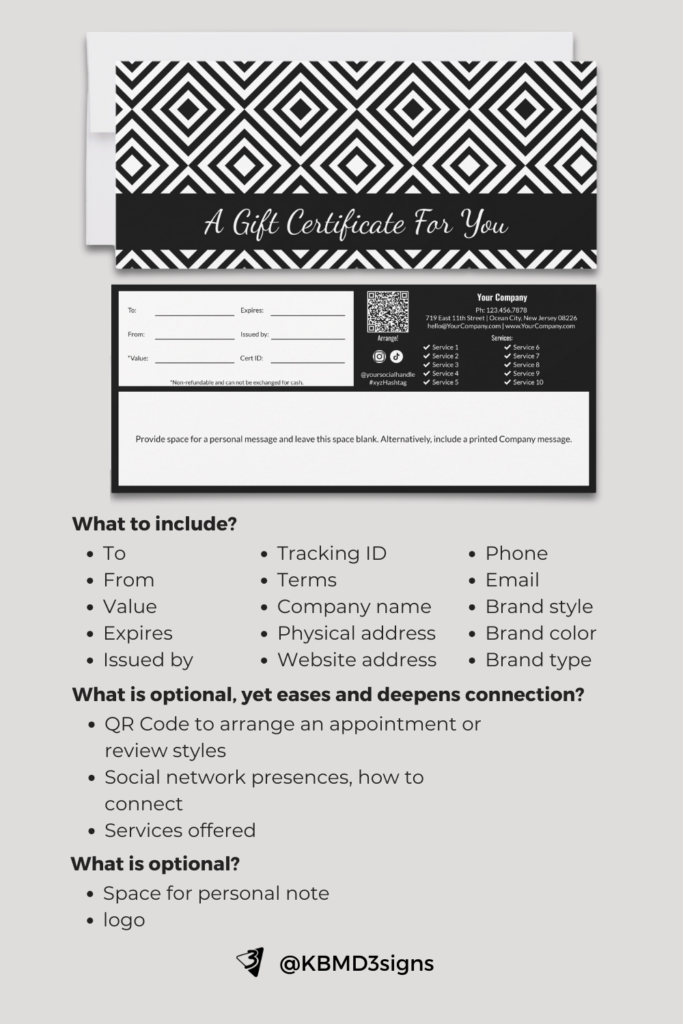
4-1. Business Name and Logo
Your business name and logo are the most important elements on the gift certificate. They should be prominently displayed, ideally at the top or center, to ensure immediate brand recognition. Use your brand’s colors and fonts to maintain consistency with your other marketing materials.
4-2. Certificate Value or Service Description
Clearly state the value of the gift certificate or specify the service(s) it covers. For example, it could read “$50 Value” or “Good for One 60-Minute Massage.” Make sure the text is legible and easy to understand, as this is the primary information the recipient will need.
4-3. Recipient’s Name
Including a space for the recipient’s name adds a personal touch. This field can be handwritten or filled in digitally, depending on how the certificate is issued. Personalization makes the certificate feel more like a thoughtful gift.
4-4. Expiration Date and Terms
Specify any expiration date or usage terms, such as “Valid for six months from the date of purchase” or “Not redeemable for cash.” This information should be clear and easy to find, usually at the bottom or back of the certificate. This ensures transparency and helps avoid any potential confusion.
4-5. Redemption Instructions
Provide simple instructions on how the certificate can be redeemed. This might include booking procedures, contact information, or mentioning if it can be redeemed online. Clarity here ensures a smooth experience for the recipient.
4-6. Contact Information
Include your business’s contact details, such as a phone number, email address, and website. This information is essential for both the purchaser and the recipient, as they may need to get in touch for questions or to redeem the certificate.
4-7. Unique Code or Serial Number
To prevent fraud and track usage, add a unique code or serial number to each gift certificate. This code can be used by your business to verify the certificate when it’s redeemed. Place this code in a discreet but accessible area, like a bottom corner.
4-8. Design Elements and Imagery
Incorporate design elements that reflect your brand’s identity. This could include colors, patterns, or images that represent your services. For instance, a spa might use calming colors and images of nature, while a salon might use sleek, modern designs. The visual appeal of the certificate can enhance its perceived value as a gift.
4-9. Signature Line
A signature line for the issuer adds a professional touch and can be used to authenticate the certificate. This is particularly important for higher-value certificates or personalized services.
4-10. Optional: Space for a Personal Message
Including space for the giver to write a personal message can make the gift certificate even more special. This area should be left blank or lightly bordered to encourage a handwritten note.
Conclusion
A well-designed gift certificate does more than just represent a transaction; it reflects your brand and enhances the gifting experience. By thoughtfully including the essential elements, you ensure that your gift certificates are not only functional but also visually appealing and aligned with your brand’s identity. This attention to detail can turn a simple piece of paper into a powerful marketing tool that delights both the giver and the recipient.
5. Sample KBM D3signs Gift Certificate Templates and Customization Options
At KBM D3signs, we believe that gift certificates should not only be practical but also a true reflection of your brand’s style. That’s why we offer meticulously designed templates that are easy to personalize, allowing you to create a product that aligns perfectly with your vision.
Whether you prefer a compact business card size for convenience or a larger 5×7 greeting or rack card for maximum impact, our range of flat and folded options ensures you have the space you need to include essential details and a personal touch.
A Year of Gift Certificates
Each month features a unique design tailored to promote seasonal services, making it easy to align your marketing with the calendar year. These themed gift certificates can be effortlessly promoted in-store, through flyer drops, or as part of your digital marketing strategy.
Occasions for Gift Certificates
Gift certificates are a fantastic way to highlight special occasion services, such as Mother’s Day, Father’s Day, graduations, Easter, and birthdays. These occasion-specific designs help attract customers looking for thoughtful, service-based gifts.
Bonus Vouchers & Promotions
For added value, consider pairing your gift certificates with bonus vouchers or promotional flyers. These can incentivize new customers while encouraging repeat business.
Easy Customization & Branding Control
Each of our gift certificate templates is part of a larger, cohesive collection, ensuring a consistent color scheme and professional look across all branding materials. Customization is simple:
- Upload your logo
- Add your text
- Insert your QR code details
For full branding flexibility, our Cocoon It! Store on Zazzle allows you to adjust the color of every element of the design. Use the “Edit Further” link to customize colors and fonts, ensuring your brand identity remains front and center. Alternatively, start your own gift certificate from scratch.
Need help selecting the perfect hues? Theses are the color color tools we use, and curated color palette ideas provide inspiration to make your gift certificates truly stand out.
Need Assistance? We’re Here to Help!
Whether you need guidance with customization, transferring designs to other products, or a completely unique design, the KBM D3signs team is just a message away. We’re committed to helping you craft marketing materials that enhance your brand with creativity and personalization.
Shop at Zazzle Store
Cocoon It! – Gift Certificates
Create your own gift certificate design on Zazzle.
Show off your personal style or post a review!
6. Seasonal Gift Certificate Promotions: A Step-by-Step Guide
Seasonal gift certificate promotions are an excellent way to boost sales and attract new customers during key times of the year. Whether for holidays, Mother’s Day, or other special occasions, these promotions can create a sense of urgency and encourage customers to purchase gifts for their loved ones. Here’s how to plan and execute a successful seasonal gift certificate promotion for your small service business:
6-1. Identify the Occasion and Set Objectives
Occasion Selection: Decide on the specific holiday or occasion you want to target. Popular choices include Christmas, Valentine’s Day, Mother’s Day, and back-to-school season. Consider your target audience and the services you offer to choose the most relevant occasion.
Objective Setting: Determine your goals for the promotion. Are you aiming to increase foot traffic, attract new customers, or boost sales during a slow season? Clear objectives will guide your strategy and help measure success.
6-2. Design Themed Gift Certificates
Visual Design: Create a special design for the gift certificate that reflects the theme of the occasion. For example, use festive colors and holiday motifs for Christmas or floral patterns for Mother’s Day. The design should evoke the spirit of the occasion while maintaining your brand’s identity.
Offer Details: Decide if you want to include a special offer, such as “Buy $100, Get $10 Free” or “20% Off Next Service with Purchase.” Highlight this offer prominently on the certificate to attract attention.
6-3. Prepare Marketing Materials
In-Store Displays: Design posters, banners, or table displays to promote the gift certificates within your store. Place them in high-traffic areas, such as the checkout counter, to capture customer interest.
Local Flyers: Print and distribute flyers in your local community. Include eye-catching visuals, a brief description of the promotion, and details on where to purchase the certificates. Consider partnering with nearby businesses to co-distribute flyers.
Direct Mail Campaigns: Send postcards or brochures to your mailing list announcing the promotion. Personalize the message for existing customers, thanking them for their loyalty and encouraging them to share your services with friends and family through gift certificates.
6-4. Launch a Multi-Channel Promotion
Social Media: Announce the promotion on your social media platforms with themed graphics and engaging captions. Create a series of posts leading up to the occasion, highlighting the benefits of giving a gift certificate. Use hashtags relevant to the occasion and your industry to reach a broader audience.
Email Marketing: Send a dedicated email to your customer list promoting the seasonal gift certificates. Include images of the certificate, details of the promotion, and a clear call to action (e.g., “Purchase Now”).
Website and Blog: Feature the promotion on your website’s homepage and write a blog post about why your gift certificates make the perfect gift for the season. Include customer testimonials and examples of services the certificate can be used for.
6-5. Train Your Staff
In-Store Promotion: Ensure your staff is well-informed about the promotion and can confidently explain the details to customers. Train them to suggest the gift certificates as an add-on during transactions, especially for customers purchasing other gifts.
Customer Interaction: Encourage staff to mention the promotion during customer interactions, offering suggestions on how the certificate could make a thoughtful gift for someone special.
6-6. Track Sales and Customer Feedback
Sales Monitoring: Track the sales of the seasonal gift certificates against your objectives. Monitor which channels (in-store, online, direct mail) are driving the most sales.
Customer Feedback: Collect feedback from customers who purchase or redeem the certificates. Understanding their experience can help you refine future promotions and enhance customer satisfaction.
6-7. Analyze Results and Refine Future Promotions
Post-Promotion Analysis: After the promotion ends, review your results. Did you meet your sales goals? Which marketing channels were most effective? Analyzing this data will help you understand what worked and what didn’t.
Refinement for Next Time: Use the insights gained to improve future seasonal promotions. For example, if social media drove most of the sales, you might invest more in that channel next time.
Conclusion
Seasonal gift certificate promotions are a highly effective way for small service businesses to capitalize on the gift-giving spirit of special occasions. By following these steps, you can create a well-rounded promotion that not only increases sales but also strengthens your brand’s presence in your community.
7. Ease of Implementation: Managing Sequential Tracking Codes for Printed Gift Certificates
For small businesses that use printed gift certificates, managing sequential tracking codes can be straightforward, even without advanced point-of-sale (POS) systems. When using a print-on-demand service to order a batch of certificates, it’s essential to plan how these codes will be applied and tracked. Here’s how to do it effectively:
7-1. Pre-Design the Tracking Code Field
- Before placing your order, ensure your gift certificate template includes a designated field for the tracking code. This field should be in a consistent location on each certificate, typically in a corner or along the bottom edge. The font should be clear and legible, but not so prominent that it detracts from the design.
7-2. Generate Sequential Codes
- Sequential codes are critical for tracking and validation. You can generate these codes manually using spreadsheet software like Excel or Google Sheets, or you can use a dedicated code generator. The format could be numeric (e.g., 0001, 0002, 0003) or alphanumeric (e.g., GFT001, GFT002, GFT003) to add complexity and avoid duplication.
7-3. Integrate Codes into the Template
- If the print-on-demand service allows for variable data printing (VDP), you can upload your list of sequential codes and have them automatically placed on each certificate during the printing process. This method ensures accuracy and saves time. Check with your print provider to confirm if they offer this service.
- If VDP is not available, you can print the certificates with a blank field for the tracking code and manually add the codes later using a stamp, label, or handwriting. This method is less automated but can still be efficient for small batches.
7-4. Order in Batches
- When using print-on-demand services, it’s advisable to order your certificates in manageable batches. For example, if you anticipate selling 100 certificates, order them in groups of 25 or 50. This approach allows you to control the sequence of codes more easily and avoid large numbers of unused certificates.
7-5. Create a Tracking Log
- Maintain a simple tracking log, either in a spreadsheet or a physical ledger, where you record each certificate’s sequential code, the sale date, the purchaser’s name, and any relevant details about the recipient. This log will be essential for verifying certificates when they are redeemed and for accounting purposes.
7-6. Monitor Redemptions
- When a customer redeems a gift certificate, cross-reference the code with your tracking log to confirm its validity. Mark the code as redeemed in your system to prevent reuse. This step is crucial for maintaining control over your certificates and ensuring that your tracking remains accurate.
7-7. Reorder and Update Codes
- When you need to reorder certificates, start the next batch with a new range of sequential codes. For example, if your first batch used codes GFT001 to GFT050, the next batch could start with GFT051. Keeping a clear and orderly sequence helps avoid confusion and ensures you can track every certificate effectively.
Conclusion
By implementing these steps, small businesses can manage printed gift certificates with sequential tracking codes efficiently, even without a sophisticated POS system. The key lies in careful planning, maintaining accurate records, and choosing a print-on-demand service that can accommodate your needs. This approach not only simplifies the process but also ensures that your gift certificates are secure, traceable, and easy to manage.
-
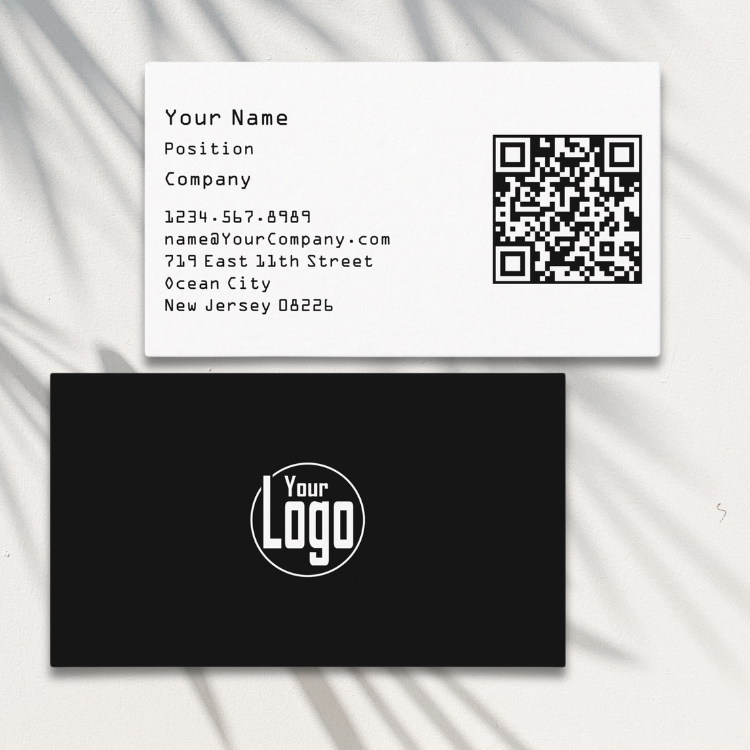
How To Design Scannable Business Cards?
Read the post …: How To Design Scannable Business Cards? -

Door Hanger Marketing: A Strategic Tool For Successful Promotions
Read the post …: Door Hanger Marketing: A Strategic Tool For Successful Promotions -
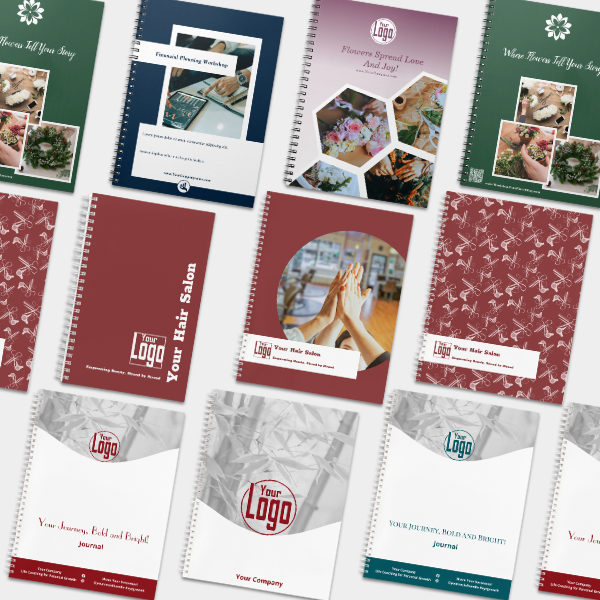
Custom Notebooks With Logo: SMB Essential For Offline Marketing
Read the post …: Custom Notebooks With Logo: SMB Essential For Offline Marketing
8. Frequently Asked Questions About “Gift Certificates”?
A gift certificate is a prepaid card or paper voucher that represents a specific monetary value or service. The recipient can use it to pay for products or services offered by the issuing business.
Gift certificates generate upfront revenue, attract new customers, and encourage repeat business. They are also a great way to increase brand visibility and promote your services.
Essential elements include the business name and logo, certificate value or service description, recipient’s name, expiration date, redemption instructions, contact information, and a unique tracking code.
Expiration policies vary by location. Some regions have laws that prohibit or limit expiration dates on gift certificates, while others allow businesses to set their own terms. Always clearly state the expiration date on the certificate if applicable.
Typically, gift certificates are not redeemable for cash, and this should be clearly stated in the terms and conditions. However, some jurisdictions may require that a small balance be refunded in cash if the remaining value is below a certain threshold.
Use unique tracking codes or serial numbers on each certificate. Keep a log of issued certificates and cross-reference the tracking codes during redemption to ensure authenticity.
Replacement policies should be clearly stated. Some businesses may replace lost or stolen certificates if the original tracking code can be provided, while others may not offer replacements.
Maintain a tracking log that records each certificate’s unique code, purchase date, purchaser’s name, and redemption status. This can be done using a spreadsheet or simple accounting software.
Decide if you want to allow gift certificates to be combined with other offers. If there are restrictions, clearly communicate them on the certificate and in your promotional materials.
If you have an online presence, offering digital gift certificates can expand your reach. Ensure your website has a secure payment system and clear instructions for purchasing and redeeming certificates online.
Seasonal promotions tap into the gift-giving spirit of holidays and special occasions, boosting sales during peak periods. These promotions also introduce your business to new customers who might not have discovered you otherwise.
Use a multi-channel approach, including in-store displays, social media, email marketing, local flyers, and direct mail. Highlight the certificates as a perfect gift option during special occasions or holidays.
A gift certificate is typically a paper document with a specific value or service. A gift card is usually plastic, with a magnetic strip or barcode, and can be reloaded. A voucher is often a coupon for a specific service, product, or discount rather than a fixed monetary value.
Yes, if the value of the certificate exceeds the cost of the service or product, the remaining balance can be tracked for future use. Ensure your tracking system can handle partial redemptions.
Offer the option to customize the recipient’s name, include a personal message, or even select a design that matches the occasion, like birthdays, holidays, or anniversaries.
-

How to Make a Brand? – A Guide for Small Businesses
Read the post …: How to Make a Brand? – A Guide for Small Businesses -

How to Choose Brand Colors – A Comprehensive Guide
Read the post …: How to Choose Brand Colors – A Comprehensive Guide -

A Brand Style Guide & A Brand Mood Board & How to Differentiate
Read the post …: A Brand Style Guide & A Brand Mood Board & How to Differentiate



